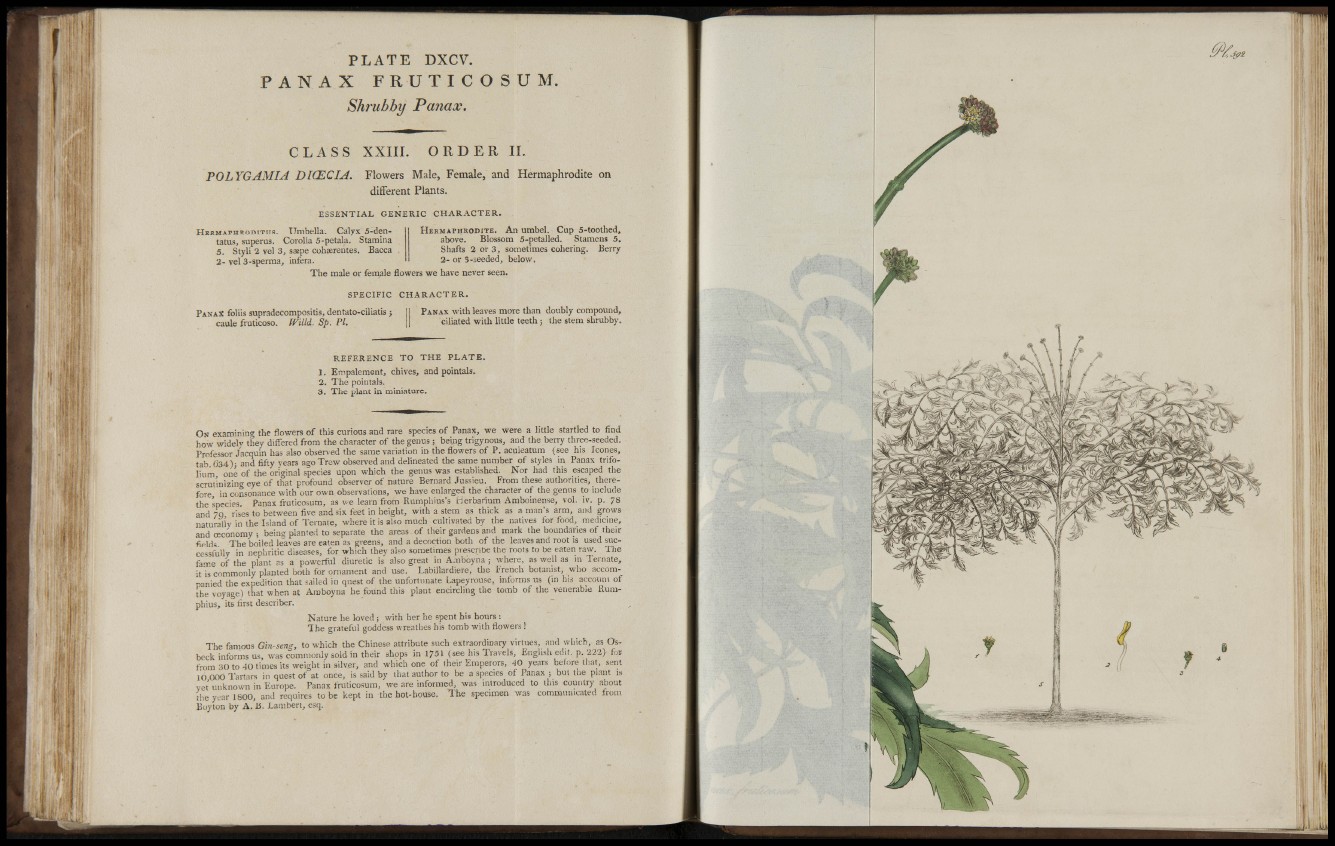
[i i
: jiii
• '' L W'
P L A T E DXCV.
P A N A X FRUTICOSUM.
Shrubby Pa?iax.
C L A S S XXIIL ORDER IL
POLYGAMIA DICECIJ. Flowers Male, Female, and Hermaphrodite on
different Plants.
E S S E N T I A L GENERIC CHARACTER.
HERMAPHRODITUS. Umbella. Calyx 5-dentatus,
superus. Corolla 5-petala. Stamina
5. Styli 2 vel 3, saepe cohsereutes. Bacca
2- vel 3-spermaj infera.
HERMAPHRODITE. An umbel. Cup 5-toothed,
above. Blossom 5-petalled. Stamens 5.
Shafts 2 or 3, sometimes cohering. Berry
2- or S-seeded, below.
Tlie male or female flowers we have never seen.
S P E C I F I C CHARACTER.
PANAX foHls supradecompositis, dentato-ciliatis J
caule fruticoso. IFilld. Sp. PL
PANAX with leaves more than doubly compound,
ciliated with little teeth; the stem shrubby.
R E F E R E N C E TO THE PLATE.
1. Empalement, chives, and pointals.
2. The pointals.
3. The plant in miniature.
ON examining the flowers of this curious and rare species of Panax, we were a little startled to find
how widelv they differed from the character of the genus ; being trigynous, and the berry three-seeded.
Professor j'acquin has also observed the same variation in the flowers of P. aculeatum (see his Icones,
tab 034)- and fifty years agoTrew observed and delineated the same number of styles in Panax Irifolium
one of the original species upon which the genus was established. Nor had this escaped the
scrutinizing eye of that profound observer of nature Bernard Jussieu. From these authorities, therefore
in consonance with our own observations, we have enlarged the character of the genus to include
the species. Panax fruticosum, as we learn from Rumphius's Herbarium Amboinense, vol. iv. p. 78
and 7Q rises to between five and six feet in height, with a stem as thick as a man's arm, and grows
naturaliv in the Island of Ternate, where it is also much cultivated by the natives for food, medicine,
and osconomy s being planted to separate the areas of their gardens and mark the boundaries of their
fields The boiled leaves are eaten as gi'eens, and a decoction both of the leaves and root is used successfully
in nephritic diseases, for which they also sometimes prescribe the roots to be eaten raw. The
fame of the plant as a powerful diuretic is also great in A.nboyna 5 where, as well as in Ternate,
i t ' i s c o m m o n l y planted both for ornament and use. Labillardiere, the trench botanist, who accompanied
the expedition that sailed in quest of the unfortunate Lapeyrouse, informs us (m his account of
the voyage) that when at Araboyna he found this plant encircling the tomb of the venerable Kuniphius,
its first describer.
Nature he loved; with her he spent his hours :
The grateful goddess wreathes bis tomb with flowers!
The famous Ginseng, to which the Chinese attribute such extraordinary virtues, and which, as Osbeck
informs us, was commonly sold in their shops in 1751 (see his Travels, English edit. p. 222) for
f-ora 30 to 40 times its weight in silver, and which one of their Emperors, 40 years before tiiat, sent
10 000 Tartars in quest of at once, is said by that author to be a species of Panax ; but tne plant i.s
vet unknown in Europe. Panax fruticosum, we are informed, was introduced to this country about
the year 1800, and requires to be kept in the hot-house. The specimen was communicated from
Buyton by A. B. Lambert, esq.
ili